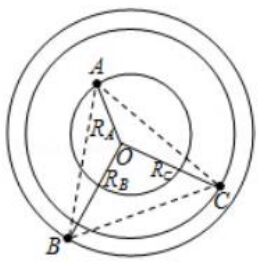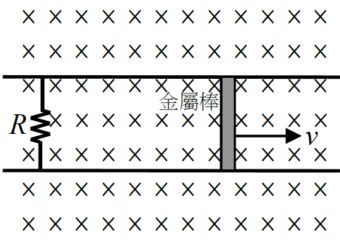載入中..請稍候..
15.由三顆星體構成的系統,忽略其他星體對它們的作用,存在著一種運動形式:三顆星體在相互之間的萬有引力作用下,分別位於等邊三角形的三個頂點上,繞一共同的圓心O在三角形所在平面內做相同角速度的圓周運動,如圖所示。若A星體質量為2m,B、C兩星體的質量均為m,三角形的邊長為a,求:(已知萬有引力常數為G)
(2)C星體作圓周運動的週期為_____。(以G、m及a表示)
(1)B星體所受A、C星體萬有引力的合力大小為_____。(以G、m及a表示)
14.考慮如圖的線路,右邊是質量為m而長度為的金屬棒,可以在導線上滑動形成導通的迴路,且滑動時摩擦力可忽略不計。將整個迴路放置於量值為B、方向為射入紙面(以x表示)的均勻磁場中,除了電阻R外,假設此迴路其餘部分的電阻皆可忽略。如果金屬棒有一初速v,則經過一段特定時間t=0.69τ之後,金屬棒的速率就會減半成 ,而且τ大致上與初速無關。其原理是因為電磁感應:金屬棒的運動造成迴路的磁通量改變,產生感應電流,而此電流讓運動中的金屬棒,在磁場中受到一反向的磁力,因此會減速,且感應電流在電阻R上會產生功率消耗。求τ=。(以m、R、ℓ、B表示)(註:ℓn2=0.69)
,而且τ大致上與初速無關。其原理是因為電磁感應:金屬棒的運動造成迴路的磁通量改變,產生感應電流,而此電流讓運動中的金屬棒,在磁場中受到一反向的磁力,因此會減速,且感應電流在電阻R上會產生功率消耗。求τ=。(以m、R、ℓ、B表示)(註:ℓn2=0.69)
IV. Reading Comprehension:
A growing body of research calls into question the ecological validity of highly sanitized laboratory environments in modeling complex biological phenomena. In a recent investigation, researchers explored how environmental exposure influences host immunity by relocating genetically identical mice from sterile laboratory housing to semi-natural outdoor enclosures. These “rewilded” mice displayed a pronounced increase in susceptibility to Trichuris muris, a gastrointestinal helminth frequently used in immunological studies due to its similarity to human parasites.
Under conventional lab conditions, mice mounted robust type 2 immune responses that effectively expelled the worms.However, when exposed to outdoor conditions, the same animals exhibited elevated worm loads and greater total biomass. The effect scaled with time spent outdoors, implying a cumulative influence of environmental complexity. Researchers attributed this to two interlinked mechanisms: a diversification of the gut microbiota and a shift in immune response bias. Outdoor microbial exposure introduced bacterial taxa that likely facilitated worm development and concurrently skewed immune signaling toward type 1 responses. Although beneficial for combating viruses and bacteria, such responses are ill-suited for clearing helminth infections.
This study reveals a critical shortcoming in traditional laboratory models: their failure to capture the dynamic interplay between host immunity and environmental variables. By minimizing ecological inputs, such models risk generating internally consistent but externally misleading conclusions. Immune systems are adaptive and context-sensitive—they do not function in isolation from their surroundings.
The authors advocate for integrating controlled ecological variation into experimental design. Rewilded models offer a closer approximation of real-world host-pathogen interactions and illuminate how environmental context can recalibrate immune
function. Such approaches may prove essential in improving the translational accuracy of preclinical findings, particularly for diseases shaped by microbiota diversity, pathogen load, and immunological trade-offs.
30. What broader implication does the study suggest for preclinical biomedical research? (A) That genetic homogeneity among lab animals undermines experimental reliability. (B) That standardized protocols are sufficient when microbial exposure is controlled. (C) That helminth infections are more dangerous than previously believed. (D) That environmental factors must be integrated to enhance translational relevance.
29. Which of the following best describes the authors’ proposed solution to the limitations of current experimental models? (A) Eliminating parasite exposure in experimental protocols. (B) Using only wild-caught animals in immunological studies. (C) Introducing controlled ecological variables to better simulate natural immune conditions. (D) Replacing in vivo models with computer-simulated immune systems.
28. Why do the authors highlight the parallel between Trichuris muris and human parasites? (A) To question its relevance as a model organism. (B) To argue that humans are also susceptible to rewilding effects. (C) To justify its selection as a valid proxy for studying human immunity. (D) To emphasize the evolutionary relationship between rodents and humans.
This is a large modal.